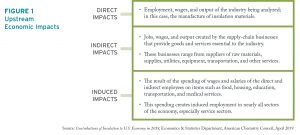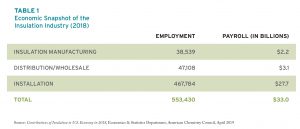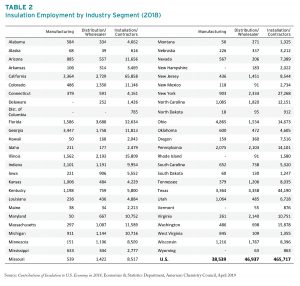Don’t Underestimate the Contributions of the Mechanical Insulation Industry to the U.S. Economy
The National Insulation Association is a member of the Insulation Industry National Policy Council, which holds a legislative day on Capitol Hill each year and contributes to an economic study released by the American Chemistry Council (ACC) on the contributions of insulation to the U.S. economy. For 2018, the study found that the insulation industry—including the manufacture, distribution, and installation of insulation—generates more than 550,000 jobs in the United States, and more than $33 billion in payrolls that support families and local communities around the country.

Have you ever thought about what impact the insulation industry has on the overall U.S. economy? In comparison to many industries, the insulation industry is relatively small; but its impact should not be underestimated. The following is an analysis of the data from The Contributions of Insulation to the U.S. Economy in 2018, published in April 2019 by the Economics and Statistics Department of the American Chemistry Council (ACC). Where applicable, the author’s comments calling attention to changes from the 2017 report appear in italics.
“The use of insulation in U.S. homes and businesses saves energy, putting more money in the pockets of home and
business owners. In addition, by consuming less energy, the use of insulation directly reduces greenhouse gas emissions.
“Beyond the benefits of the use of insulation, the insulation industry—including the manufacture, distribution, and installation of insulation—generates more than 550,000 jobs in the U.S. and $33 billion in payrolls that support families and local communities around the country.”
Note: This represents a 10% increase in both categories over 2017.
“Insulation materials manufacturing is a $15.6 billion business, and directly employs more than 38,000 people across 45 states.”
Note: This represents a 12.2% increase in business and 15% increase in employment.
“Indirectly, through its purchases of supplies, raw materials, equipment, and services, insulation manufacturing supports an additional 56,400 jobs in supply-chain industries. Through the household spending of the wages and salaries paid to workers in insulation manufacturing and their suppliers, an additional 63,900 payroll-induced jobs are supported.”
Note: This represents an additional 4,400 supply-chain and 3,900 payroll-induced jobs over 2017, an 8.5% and 6.5% increase, respectively, over 2017.
“The combined direct and indirect economic activity from U.S. insulation manufacturing supports nearly 160,000 jobs. These jobs generate payrolls of $8.4 billion. In addition, the combined economic activity supported by insulation manufacturing contributes $1.3 billion to state and local governments and $2.4 billion in federal tax revenues.”
Note: The combined jobs are up 6.7%, payrolls have increased 2.4%, and state and local tax revenues have increased 8.3%, while federal tax revenue has remained constant.
Clearly, the insulation industry remains a strong contributor to the U.S. economy, although in many circles, the industry is often undervalued and underappreciated.
The report takes into consideration the full range of materials utilized in residential, commercial (envelope, roofing, and mechanical systems), industrial, and OEM (appliances and automotive) applications. It also describes upstream and downstream economic impacts. Upstream impacts are shown in Figure 1.
In considering the downstream economic impact, the report noted: “Looking downstream, nearly 47,000 wholesalers distribute insulation products to contractors/installers and retailers around the country and nearly 468,000 workers are engaged in the drywall and insulation installation, nonresidential roofing, and mechanical insulation installation. Payrolls in those sectors amount to $3.1 billion and $27.7 billion, respectively. The paychecks from these workers help support families and local economies throughout the U.S.”
Methodology as Applied to Mechanical Insulation Segment
The ACC report is a great representation of the total impact that the insulation industry has on the U.S. economy. NIA applauds ACC’s efforts, the methodology used, and the report contributors. We also wondered if the overriding report data could be dissected to determine the impact of the mechanical insulation segment.
First, we had to consider that many of the insulation manufacturers included in the upstream direct impact data produce materials in several facilities that cross over traditional market boundaries, which influences the upstream and downstream calculations.
Second, we determined there was not a substantial upstream indirect overlap with the supply chain and contracting of mechanical insulation versus other insulation segments.
And third, we needed to develop a methodology by which to carve out the mechanical insulation segment from other industry segments.
ACC produced its first report in 2016, but it did not include the mechanical insulation segment, which encompasses all thermal, acoustical, and personnel safety requirements in the following commercial and industrial markets:
- Mechanical piping and equipment, hot and cold applications;
- HVAC applications; and
- Refrigeration and other low-temperature piping and equipment applications.
By comparing the ACC’s 2016 and 2017 reported data, combined with analysis of the information provided by NIA to ACC for compiling the 2017 report, we were able to extrapolate the potential mechanical insulation impact on the U.S. economy for 2017. Following are excerpts from the ACC Executive Summary (noted in bold italics) and NIA’s best estimate of the mechanical insulation industry component (noted in gold). After reexamining the methodology utilized in 2017 to extrapolate the impact of the mechanical insulation industry, we believe the mechanical insulation industry representation on a percentage basis is very similar to 2017.
ACC indicates that the insulation industry—including insulation manufacturing, distribution/wholesale, and installation—generates 553,430 jobs in the United States and $33 billion in payrolls that support families and local communities around the country (see Table 1 and Table 2).
We estimate the mechanical insulation industry represents approximately 24% of those jobs—and potentially as much as $9 billion of the payroll dollars.
Insulation manufacturing is a $15.6 billion business and directly employs nearly 38,000 workers across 42 states. We estimate that of those 38,000 manufacturing jobs, 16,000 +/- (43%) manufacture materials used in the mechanical insulation industry.
We also estimate the mechanical insulation industry indirectly, through its purchases of supplies, raw materials, equipment, and services for the manufacturing of insulation, supports an additional 9,500 +/- (17%) of the 56,000 jobs in supply-chain industries. From the household spending of the wages and salaries paid to workers and suppliers in insulation manufacturing, an additional 10,000 +/- (16%) of the 64,000 payroll-induced jobs are supported.
The report states, “In addition, the combined economic activity supported by insulation manufacturing contributes $1.3 billion to state and local governments and $2.4 billion in federal tax revenues.” While it is difficult to extract the mechanical insulation component for these totals, the mechanical insulation segment could represent over half a billion dollars in federal and state income tax.
Every 2 years, NIA conducts a survey to gauge the size of the mechanical insulation and laminated metal building insulation industry segments. The first survey, in 1997, sought to gain data about the size of the mechanical insulation industry, which had not been measured before that time. In 2013, the laminated metal building insulation segment was added to the survey. The expanded survey aims to provide valuable data regarding market size and growth rates for the U.S. commercial and industrial mechanical and laminated metal building insulation market.
Sponsored by NIA’s Foundation for Education, Training, and Industry Advancement, the survey is sent to NIA’s Associate members, who are manufacturers of insulation products or insulation accessories, and the metal building laminator members. Those members are asked to provide information about their sales volume. A third-party company—using formulas created by NIA and the information gathered—determines the annual size of the respective U.S. insulation industry segments. (For the full survey report and analysis, read the “The Commercial and Industrial Mechanical Insulation and Laminated Metal Building Insulation Markets Exhibit Overall Growth” in the July 2019 issue of Insulation Outlook.)
NIA’s survey indicated the 2018 market grew by 9.8% from 2016. 2017 saw an increase of 2%, while 2018 experienced an increase of 7.9%. Growth in 2019 and 2020 is forecast at 6.2% and 4.8%, respectively. The 2020 U.S. mechanical insulation industry is forecast to reach $12.4 billion in 2020.
While the ACC report and NIA surveys were conducted at different times and employed different methodologies, the results support similar conclusions. Clearly, the insulation industry makes vital contributions to the U.S. economy. The industry also delivers many environmental benefits, such as reduced energy consumption, which translates directly into lower emissions of greenhouse gases. Insulation—specifically, mechanical insulation—promotes employee and public safety, protects the environment, and contributes to the competitiveness of U.S. industry by lowering operating and production costs.
The economic activity generated by the U.S. insulation industry is broad based and helps support economic segments across the entire U.S. economy, from manufacturing to distribution/fabrication, to installation. The mechanical insulation segment is a substantial part of the overall insulation industry, and its contribution to the U.S. economy is impressive.
Source: The Contributions of Insulation to the U.S. Economy in 2018, Economics & Statistics Department, American Chemistry Council, April 2019
Copyright 2019 National Insulation Association. All rights reserved.



